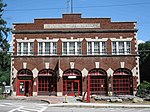Kenyon Bridge
Bridges completed in 1882Bridges in Sullivan County, New HampshireCornish, New HampshireCovered bridges in New HampshireHistoric American Engineering Record in New Hampshire ... and 4 more
King post truss bridges in the United StatesNational Register of Historic Places in Sullivan County, New HampshireRoad bridges on the National Register of Historic Places in New HampshireWooden bridges in New Hampshire

The Kenyon Bridge, also known as the Blacksmith Shop Bridge, is a historic covered bridge spanning Mill Brook near Town House Road in Cornish, New Hampshire, United States. Built in 1882, it is one of New Hampshire's few surviving 19th-century covered bridges. It was listed on the National Register of Historic Places in 1978.
Excerpt from the Wikipedia article Kenyon Bridge (License: CC BY-SA 3.0, Authors, Images).Kenyon Bridge
Fuchy Road,
Geographical coordinates (GPS) Address External links Nearby Places Show on map
Geographical coordinates (GPS)
| Latitude | Longitude |
|---|---|
| N 43.463055555556 ° | E -72.353333333333 ° |
Address
Kenyon Bridge
Fuchy Road
03745
New Hampshire, United States
Open on Google Maps











